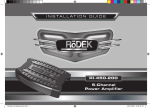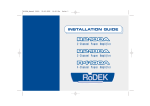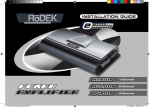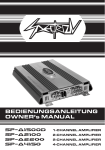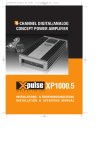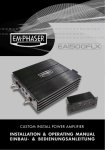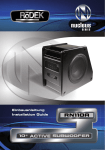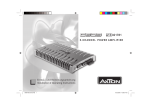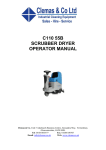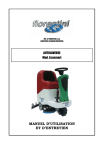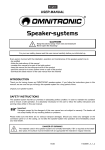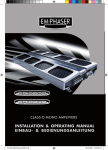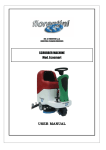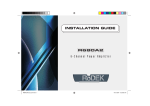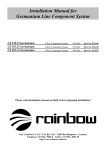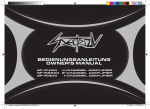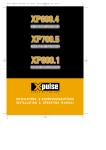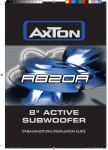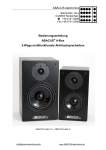Download INSTALLATION GUIDE
Transcript
I N S TA L L AT I O N G U I D E
RI-4100
RI-2135
RI-1650D
1/2/4-Channel Power Amplifier
RI-Amp 1-2-4-CH Manual_D+E.indd 1
05.01.2008 12:32:17 Uhr
INHALTSVERZEICHNIS / CONTENTS
Seite
1. TECHNISCHE MERKMALE.................................................................................................................... 4-11
2. EINGÄNGE-AUSGÄNGE-BEDIENUNGSELEMENTE.............................................................................. 5-10
3. MONTAGE................................................................................................................................................. 11
3.1 WAHL DES EINBAUORTES....................................................................................................................................................11
3.2 MINIMALE LASTIMPEDANZ..................................................................................................................................................11
4. ELEKTRISCHER ANSCHLUSS................................................................................................................ 12
4.1 VERLEGEN VON PLUS- UND MINUSKABEL.........................................................................................................................12
4.2 VERLEGEN VON CINCHKABEL / REMOTE-KABEL..............................................................................................................12
4.3 ANSCHLUSS DER LAUTSPRECHER-KABEL.......................................................................................................................12
5. EINSTELLUNG DER INTEGRIERTEN
FREQUENZWEICHE.............................................................................................................................. 14-20
5.1 TRENNFREQUENZ-EINSTELLUNGEN..................................................................................................................................13
5.2 SYSTEMKONFIGURATIONEN.......................................................................................................................................... 14-16
5.3 HIGHPASS FÜR KOMPONENTEN UND KOAXIAL SYSTEME..............................................................................................17
5.4 BANDPASS FÜR SUBWOOFER SYSTEME (RI-1650D).........................................................................................................18
5.5 LOWPASS FÜR SUBWOOFER SYSTEME (RI-2135, RI-4100) ................................................................................................18
5.6 ANPASSUNG DER EINGANGSEMPFINDLICHKEIT..............................................................................................................19
5.7 PHASE-SHIFT WAHLSCHALTER...........................................................................................................................................19
6. TECHNISCHE SPEZIFIKATIONEN.......................................................................................................... 38
7. GARANTIEBESTIMMUNGEN................................................................................................................... 39
7.1 GARANTIEKARTE..................................................................................................................................................................40
2
RI-Amp 1-2-4-CH Manual_D+E.indd 2
05.01.2008 12:32:17 Uhr
1- / 2- AND 4-Channel Power Amplifiers
Herzlichen Glückwunsch!
Wir gratulieren Ihnen zum Kauf dieser RODEK Car-Hifi Endstufe.
Damit Sie die Wiedergabequalität und die Leistungsfähigkeit dieses Verstärkers voll ausschöpfen können, bitten wir Sie, sich eingehend mit den Möglichkeiten und technischen Features dieses Car-Amps vertraut zu machen. Lesen Sie deshalb die nachfolgenden
Abschnitte sorgfältig durch und bewahren Sie diese Bedienungsanleitung für eventuell später auftauchende Fragen auf.
Falls Sie weitere Fragen bezüglich der Anschluss- oder Einstellmöglichkeiten dieses Gerätes oder dessen Installation haben,
lassen Sie sich von Ihrem autorisierten RODEK Fachhändler beraten.
3
RI-Amp 1-2-4-CH Manual_D+E.indd 3
05.01.2008 12:32:17 Uhr
1. TECHNISCHE MERKMALE
RI-4100 und RI-2135
■ VFD DISPLAY mit Realtime Anzeige von Temperatur, Spannung, STROMFLUSS
und Gesamtausgangsleistung
■ Integrierte elektronische Frequenzweichen mit variablen Highpass-/Lowpass Filtern
■ Basspegel Fernbedienung und separater 0-18 dB BassbooSt für den Subwooferkanal
■ Futuristisches Aluminium Druckgussgehäuse mit blauer LED-Beleuchtung
■ VERDECKTE Verkabelung durch Endcaps
■ Gekapselte „Moulded“ Power und Speaker Terminals
RI-1650D
■ VFD DISPLAY mit Realtime Anzeige von Temperatur, Spannung, STROMFLUSS
und Gesamtausgangsleistung
■ ZWEI RI-1650D KÖNNEN ZUSAMMEN IM MASTER/SLAVE MODUS BETRIEBEN WERDEN
■ Integrierte elektronische Frequenzweichen mit variablen Highpass-/Lowpass Filtern
■ Basspegel Fernbedienung und separater 0-18 dB BassbooSt für den Subwooferkanal
■ Futuristisches Aluminium Druckgussgehäuse mit blauer LED-Beleuchtung
■ VERDECKTE Verkabelung durch Endcaps
■ Gekapselte „Moulded“ Power und Speaker Terminals
4
RI-Amp 1-2-4-CH Manual_D+E.indd 4
05.01.2008 12:32:17 Uhr
2. EINGÄNGE - AUSGÄNGE - BEDIENUNGSELEMENTE
RI-4100
1. Regler zum Einstellen der Tiefpass- oder HochpassTrennfrequenz der Kanäle CH1/2 an der integrierten
elektronischen Frequenzweiche
2. Schiebeschalter zum Wählen des Betriebsmodus –
LOWPASS, FULL oder HIGHPASS – der Aktivweiche für
die Kanäle CH1/2
3. LED-Wahlschalter zum Ein- und Ausschalten der
Endstufenbeleuchtung. Die Anzeige bleibt immer eingeschaltet
4. Eingangsempfindlichkeitsregler
LEVEL
des Kanalpaares CH1/2 für die Anpassung an die
Ausgangsspannung des Steuergerätes
5. Cinch Eingangsbuchsen (jeweils linker und rechter
Kanal für Front und Rear). NF-Signal Eingang für den
Anschluss der Cinch-Ausgänge des Steuergerätes
6. Cinch Ausgangsbuchsen zur Signalübertragung an
einen weiteren Verstärker, z.B. einen Mono-Verstärker
7. Eingangsempfindlichkeitsregler
LEVEL
des Kanalpaares CH3/4 für die Anpassung an die
Ausgangsspannung des Steuergerätes
9. Regler zum Einstellen der Tiefpass- oder HochpassTrennfrequenz der Kanäle CH3/4 an der integrierten
elektronischen Frequenzweiche
10. "REMOTE" Port für Basspegel-Fernbedienung Rear
Kanäle
11. "GND" für den Anschluss an die Chassis-Masse des
Kfz
12. "REM" (Remote) Anschluss für die automatische Einbzw. Abschaltung des Verstärkers über den Amp- oder
Antennen-Remote Anschluss des Steuergerätes
13. "B +" für den Anschluss an den Pluspol der Auto-Batterie
über eine Haupt-Sicherung
14. Sicherungen
15. LED Statusanzeige, leuchtet blau wenn die Endstufe
eingeschaltet und betriebsbereit ist und rot, wenn ein
Fehler beim Anschluss des Verstärkers vorliegt
16. Anschlussklemmen für die hinteren Lautsprecher
17. Anschlussklemmen für die vorderen Lautsprecher
8. Schiebeschalter zum Wählen des Betriebsmodus –
LOWPASS, FULL oder HIGHPASS – der Aktivweiche für
die Kanäle CH3/4
5
RI-Amp 1-2-4-CH Manual_D+E.indd 5
05.01.2008 12:32:17 Uhr
2. EINGÄNGE - AUSGÄNGE - BEDIENUNGSELEMENTE
RI-2135
1. "REMOTE" Port für Basspegel-Fernbedienung
2. LED-Wahlschalter zum Ein- und Ausschalten der
Endstufenbeleuchtung. Die Anzeige bleibt immer eingeschaltet
3. Regler zum Einstellen der Tiefpass- oder HochpassTrennfrequenz der Kanäle CH1/2 an der integrierten
elektronischen Frequenzweiche
9. "GND" für den Anschluss an die Chassis-Masse des
Kfz
10. REM" (Remote) Anschluss für die automatische Einbzw. Abschaltung des Verstärkers über den Amp- oder
Antennen-Remote Anschluss des Steuergerätes
11. "B +" für den Anschluss an den Pluspol der Auto-Batterie
über eine Haupt-Sicherung
12. Sicherungen
4. Schiebeschalter zum Wählen des Betriebsmodus –
LOWPASS, FULL oder HIGHPASS – der Aktivweiche für
die Kanäle CH1/2
13. LED Statusanzeige, leuchtet blau wenn die Endstufe
eingeschaltet und betriebsbereit ist und rot, wenn ein
Fehler beim Anschluss des Verstärkers vorliegt
5. Regler zum Einstellen des Bass-Boost, um etwas
mehr Basswiedergabe zu erzielen. ACHTUNG: bei zu
hoher Einstellung besteht die Gefahr einer Überlastung
der angeschlossenen Lautsprecher!
14. Anschlussklemmen für die Lautsprecher oder den
Subwoofer
6. Eingangsempfindlichkeitsregler
LEVEL
des Kanalpaares CH1/2 für die Anpassung an die
Ausgangsspannung des Steuergerätes
7. Cinch Eingangsbuchsen (jeweils linker und rechter
Kanal für Front). NF-Signal Eingang für den Anschluss
der Cinch-Ausgänge des Steuergerätes
8. Cinch Ausgangsbuchsen zur Signalübertragung an
einen weiteren Verstärker, z.B. einen Mono-Verstärker
6
RI-Amp 1-2-4-CH Manual_D+E.indd 6
05.01.2008 12:32:17 Uhr
2. EINGÄNGE - AUSGÄNGE - BEDIENUNGSELEMENTE
RI-1650D
1. LED-Wahlschalter zum Ein- und Ausschalten der
Endstufenbeleuchtung. Die Anzeige bleibt immer eingeschaltet
2. Schiebeschalter zum Wählen des Betriebsmodus
- SLAVE - oder - MASTER - Bei Verschaltung von
zwei RI-1650D einen Schalter auf - MASTER - und den
Schalter am zweiten Verstärker auf - SLAVE - stellen. Bei
Verwendung einer RI-1650D den Schalter auf - Master stellen
3. Datalink-Port zum Verschalten von zwei RI-1650D
4. "REMOTE" Port für Basspegel-Fernbedienung
5. Regler zum Einstellen der Tiefpass-Trennfrequenz
an der integrierten elektronischen Frequenzweiche
6. Regler zum Einstellen des Bass-Boost, um etwas
mehr Basswiedergabe zu erzielen. ACHTUNG: bei zu
hoher Einstellung besteht die Gefahr einer Überlastung
des angeschlossenen Subwoofers!
7. Schieberegler zum Einstellen der Phasenlage um
180 Grad
9. Eingangsempfindlichkeitsregler
LEVEL
für die Anpassung an die Ausgangsspannung des
Steuergerätes
10. Cinch Eingangsbuchsen (jeweils linker und rechter
Kanal für Front und Rear). NF-Signal Eingang für den
Anschluss der Cinch-Ausgänge des Steuergerätes
11. Cinch Ausgangsbuchsen zur Signalübertragung an
einen weiteren Verstärker, z.B. einen Mono-Verstärker
12. "GND" für den Anschluss an die Chassis-Masse des
Kfz
13. "REM" (Remote) Anschluss für die automatische Einbzw. Abschaltung des Verstärkers über den Amp- oder
Antennen-Remote Anschluss des Steuergerätes
14. "B +" für den Anschluss an den Pluspol der Auto-Batterie
über eine Haupt-Sicherung
15. LED Statusanzeige, leuchtet blau wenn die Endstufe
eingeschaltet und betriebsbereit ist und rot, wenn ein
Fehler beim Anschluss des Verstärkers vorliegt
16. Anschlussklemmen für den oder die Subwoofer
8. Regler zum Ausblenden der ultratiefen Frequenzanteile, den der angeschlossene Subwoofer bauartbedingt nicht wiedergeben kann
7
RI-Amp 1-2-4-CH Manual_D+E.indd 7
05.01.2008 12:32:18 Uhr
2. EINGÄNGE - AUSGÄNGE - BEDIENUNGSELEmENTE
FRONT PANEL
RI-4100
REAR PANEL
RI-4100
1
bm
2
bn bo
3
4
5
bp
6
bq
7
br
8 9
bl
bs
8
RI-Amp 1-2-4-CH Manual_D+E.indd 8
05.01.2008 12:32:27 Uhr
2. EINGÄNGE - AUSGÄNGE - BEDIENUNGSELEmENTE
FRONT PANEL
RI-2135
REAR PANEL
RI-2135
1
9
2
bl bm
3
4
bn
5
6
7
bo
8
bp
9
RI-Amp 1-2-4-CH Manual_D+E.indd 9
05.01.2008 12:32:35 Uhr
2. EINGÄNGE - AUSGÄNGE - BEDIENUNGSELEmENTE
FRONT PANEL
RI-1650D
1
2
3
REAR PANEL
RI-1650D
bn
bo
bp
4
5
bq
6
7 8
9
bl
bm
br
10
RI-Amp 1-2-4-CH Manual_D+E.indd 10
05.01.2008 12:32:44 Uhr
3. MONTAGE
3.1 WAHL DES EINBAUORTES
Der Montageort des Verstärker muss im Sinne einer guten Wärmeabführung als auch für die weiteren Einstellarbeiten an der
Aktivweiche des Verstärkers entsprechend platziert werden.
Als Montageort eignet sich z.B. ein Platz im Kofferraum, an der
Rücksitzbank oder an einem Seitenteil, bzw. jeder andere Ort,
der eine saubere Installation ermöglicht.
Die Endstufe wird im Betrieb heiß, es sollte also einen Abstand
von mindestens 10 cm oberhalb und auf den Seiten des AluKühlkörpers geachtet werden. Der Luftein- und Auslass (innenliegender Lüfter!) befindet sich in den Seitenabdeckungen.
Dort sollte genügend Luft zirkulieren können!
Vermeiden Sie Montageorte mit "unbekanntem Hintergrund".
Es könnten sich der Benzintank, Bremsleitungen, Kabel etc.
dahinter verbergen! Achten Sie auch auf einen trockenen, gegen mechanische Einwirkungen geschützten Installationsort,
der auch nach der Endmontage noch für die Bedienung und
Einstellung (Trennfrequenz- und EingangsempfindlichkeitsRegelung) des Verstärkers gut zugänglich ist.
3.2 MINIMALE LASTIMPEDANZ
Die RODEK Verstärker sind von der Auslegung der Endtransistoren-Sektion auf eine sehr hohe Ausgangsleistung im 4
und 2 Ohm stereo Betrieb ausgelegt (1Ohm bei der RI-1650D),
sie bieten hier eine gemessen am Preis überdurchschnittliche
Performance. Die RODEK Verstärker können auf eine 4 Ohm Last
gebrückt werden. Im Stereobetrieb darf die minimale Anschlussimpedanz von 2 Ohm pro Kanal auf keinen Fall unterschritten
werden. Dasselbe gilt auch für den Brückenmodus, wo 4 Ohm
die minimal zulässige Lastimpedanz darstellen! Die RI-1650D
treibt Subwoofer bis auf 1 Ohm Gesamtlast
Die Endstufe darf nicht mit der Kfz-Chassismasse in
Berührung kommen, sie muss also in jedem Fall isoliert
montiert werden.
11
RI-Amp 1-2-4-CH Manual_D+E.indd 11
05.01.2008 12:32:45 Uhr
4. ELEKTRISCHER ANSCHLUSS
4. ELEKTRISCHER ANSCHLUSS
ACHTUNG! Entfernen Sie vor Beginn der Arbeiten
immer das Massekabel vom Minuspol der Batterie !!
Bei allen nachfolgend beschriebenen Installationsschritten muss der Stromkreis des Kraftfahrzeugs
unterbrochen sein! Erst nach Abschluss aller Installationsarbeiten wird über das Massekabel der Stromkreis
wieder geschlossen.
4.1 VERLEGEN VON
PLUS -/ MINUS STROMKABEL
Der Stromkabelquerschnitt der Plus- und Minusleitung (bei
einer Kabellänge von ca. 5m) sollte mindestens 20mm², besser
jedoch 35mm² betragen. Bedenken Sie, dass z.B. beim Einsatz
einer weiteren (zweiten) Endstufe der Strombedarf nochmals
zusätzlich ansteigt. In diesem Falle (bei zwei Endstufen) sind
35mm² Power Kabel Querschnitt das Minimum!
Zu gering gewählte Batteriekabelquerschnitte führen zu einer
übermäßigen Erhitzung der Endstufe(n), dies lässt die Thermosicherung ansprechen und schaltet die Endstufe(n) aus!
Verwenden Sie beim Einziehen der Stromkabel Kabeltüllen aus
Gummi, um ein Durchscheuern an Blechkanten, respektive
den sonst resultierenden Kurzschluss auf Chassismasse zu
vermeiden!
4.2 VERLEGEN VON CINCHKABEL /
REMOTE-KABEL
Verlegen Sie nun das (oder die) Cinchkabel und das Remote-Kabel vom Steuergerät zur Endstufe. Diese Kabel sollten unbedingt
räumlich getrennt von der Stromzuführung des Verstärkers
eingezogen werden. Verwenden Sie mindestens doppelt oder
besser dreifach geschirmte Cinch-Kabel!
Schließen Sie das Remote-Kabel an die mit "REM" bezeichnete
Klemme an der Endstufe und an das mit "Antenna-Rem." oder
"Amplifier-Rem." bezeichnete Kabel Ihres Steuergerätes an.
Das Remote-Kabel führt eine 12 V Schaltspannung, die den
Verstärker einschaltet, wenn Sie das Steuergerät aktivieren.
Anschließend stecken Sie die Cinchkabel in die Cincheingangsbuchsen des Verstärker ein.
4.3 ANSCHLUSS DER
LAUTSPRECHER-KABEL
Verwenden Sie Lautsprecherkabel mit 2,5 mm² Querschnitt. Für
den Anschluss am Verstärker benötigen Sie Inbus-Schlüssel der
geeigneten Größe, sowie ein Messer oder eine Abisolier-Zange.
Entfernen Sie ca. 6-8 mm der Isolierung des LS-Kabels und beachten Sie beim Anschluss der Kabel am Verstärker unbedingt
die richtige Polung der Lautsprecherkabel (Plus auf Plus, Minus
auf Minus) Ziehen Sie die LS-Schraublemmen satt an.
Speziell die musiksignalführenden (Cinch-) Kabel müssen soweit
wie möglich von allen potentiellen "elektrischen Störsendern"
wie Bordcomputer, Benzinpumpe, Kabelbäumen, Stromversorgungskabel für die Beleuchtung, etc. verlegt werden!
12
RI-Amp 1-2-4-CH Manual_D+E.indd 12
05.01.2008 12:32:45 Uhr
5. EINSTELLUNG DER INTEGRIERTEN FREQUENZWEICHE
5.1 TRENNFREQUENZ-EINSTELLUNGEN
Die Hochpass- undTiefpassfunktion der integrierten Frequenzweichen Ihres Verstärkers teilt den eingesetzten Lautsprechersystemen wie Subwoofer, Koax- oder Komponentensystemen
nur den Frequenzbereich zu, für welchen die Lautsprecher
geeignet sind. Bevor abschließend die Eingangsempfindlichkeitsanpassung jedes Kanalpaares in Angriff genommen werden kann, gilt es zunächst die groben Trennfrequenzen für die
angeschlossenen Lautsprecher vorzuwählen.
13
RI-Amp 1-2-4-CH Manual_D+E.indd 13
05.01.2008 12:32:45 Uhr
5.2 SYSTEMKONFIGURATIONEN
Systemkonfiguration RI-1650D / RI-2135
RI-2135
OPERATION MODE SELECTOR
CH1/2 set to HPF
RI-1650D
RI-2135
RI-1650D = 1 ohms min.
OPERATION MODE SELECTOR
CH1/2 set to LPF
14
RI-Amp 1-2-4-CH Manual_D+E.indd 14
05.01.2008 12:32:46 Uhr
5.2 SYSTEMKONFIGURATIONEN
Systemkonfiguration RI-4100
CH1
CH2
CH3
CH4
RI-4100
OPERATION MODE SELECTOR
CH1/2 set to HPF
CH3/4 set to HPF
min.
TWEETER
TWEETER
FRONT
FRONT
MID/
WOOFER
MID/
WOOFER
TWEETER
TWEETER
REAR
REAR
MID/
WOOFER
MID/
WOOFER
15
RI-Amp 1-2-4-CH Manual_D+E.indd 15
05.01.2008 12:32:46 Uhr
5.2 SYSTEMKONFIGURATIONEN
Systemkonfiguration RI-4100
CH1
CH2
CH3
CH4
RI-4100
OPERATION MODE SELECTOR
CH1/2 set to HPF
CH3/4 set to LPF
ohms
16
RI-Amp 1-2-4-CH Manual_D+E.indd 16
05.01.2008 12:32:47 Uhr
EINSTELLUNG DER INTEGRIERTEN FREQUENZWEICHE
5.3 HIGHPASS FÜR KOMPONENTEN
UND KOAXIAL SYSTEME
Zuerst müssen am Steuergerät alle Klangregler (Bass, Treble),
Fader als auch die Loudnessfunktion in die Mittel- oder NeutralPosition gebracht werden.
Die Einstellung der Trennfrequenzen der Weichenzweige sollte gemäss den ungefähren nachfolgend gemachten Vorgaben erfolgen. Die Hochpass Trennfrequenz stellt immer einen
Kompromiss zwischen der möglichen Pegelfestigkeit und der
Midbass-Wiedergabe dar. Versuchen Sie eine Einstellung zu
finden, die Ihrem Hörgeschmack als auch der Pegelfestigkeit
der angeschlossenen Kompo-/Koax Lautsprechern Rechnung
trägt.
Satelliten-System in den Vordertüren, empfohlene Trennfrequenz Highpass
10 cm Koax- oder Komponentensysteme 120 - 200 Hz
13 cm Koax- oder Komponentensysteme 80 - 120 Hz
16 cm Koax- oder Komponentensysteme 60 - 90 Hz
Satelliten-System in den Hintertüren oder der Heckablage,
empfohlene Trennfrequenz Highpass
10 cm Koax- oder Komponentensysteme 150 - 200 Hz
13 cm Koax- oder Komponentensysteme 120 - 150 Hz
16 cm Koax- oder Komponentensysteme 80 - 120 Hz
17
RI-Amp 1-2-4-CH Manual_D+E.indd 17
05.01.2008 12:32:47 Uhr
EINSTELLUNG DER INTEGRIERTEN FREQUENZWEICHE
5.4 BANDPASS FÜR SUBWOOFER
SYSTEME (nur RI-1650D)
Die aktive Frequenzweiche für den oder die angeschlossenen
Subwoofer läuft im Bandpass Modus. Hierzu wird zuerst der
Subsonic Filter Regler im Gegenuhrzeigersinn auf 10Hz gestellt.
Er wird nach der Einstellung der Subwoofer Lowpass-Trennfrequenz später noch ermöglichen, das Subwoofer-System etwas
pegelfester zu machen.
Nun wird die Tiefpass (Lowpass) Frequenz am betreffenden
Regler eingestellt. Sinnvollerweise sollte diese im Bereich
zwischen 50 bis 90 Hz liegen. Justieren Sie den Regler nach
Gehör, dass der Klang im Bassbereich satt und trocken mit
genügend Tiefbassanteil wiedergegeben wird. Dazu müssen
Sie das Head Unit einschalten und den Level Regler auf ca. auf
12 Uhr aufdrehen, damit der Subwoofer gut hörbar wird. Eine
zu tiefe Trennfrequenz lässt den Bassbereich tiefbassbetont,
kraftlos und unkonturiert wirken. Eine zu hohe Trennfrequenz
bewirkt ein Dröhnen des Bassbereichs. Ist diese Einstellung
gefunden, sollte der Subsonic Filter Regler eingestellt werden. Er
schneidet extrem tiefe Frequenzen, welche der angeschlossene
Subwoofer nicht mehr wiedergeben kann, ab. Drehen Sie also
den Regler soweit im Uhrzeigersinn auf, bis Sie gerade hören,
dass die Basswiedergabe "dünner" wird.
5.5 LOWPASS FÜR SUBWOOFER
SYSTEME (RI-2135, RI-4100)
Nun wird die Tiefpass (Lowpass) Frequenz am betreffenden
Regler eingestellt. Sinnvollerweise sollte diese im Bereich
zwischen 50 bis 90 Hz liegen. Justieren Sie den Regler nach
Gehör, dass der Klang im Bassbereich satt und trocken mit
genügend Tiefbassanteil wiedergegeben wird. Dazu müssen
Sie das Head Unit einschalten und den Level Regler auf ca. auf
12 Uhr aufdrehen, damit der Subwoofer gut hörbar wird. Eine
zu tiefe Trennfrequenz lässt den Bassbereich tiefbassbetont,
kraftlos und unkonturiert wirken. Eine zu hohe Trennfrequenz
bewirkt ein Dröhnen des Bassbereichs.
Abschließend – nach der gleich folgenden Einstellung der
Eingangsempfindlichkeit – sollte noch eine Feineinstellung
der bereits grob gesetzten Trennfrequenz(en) erfolgen. Diese
Feineinstellung muss nach Gehör erfolgen und orientiert sich
am akustisch harmonischen Zusammenspiel der diversen
installierten Lautsprechersysteme.
18
RI-Amp 1-2-4-CH Manual_D+E.indd 18
05.01.2008 12:32:47 Uhr
EINSTELLUNG DER INTEGRIERTEN FREQUENZWEICHE
5.6 ANPASSUNG DER
EINGANGSEMPFINDLICHKEIT
Die korrekte Eingangsempfindlichkeitseinstellung ist wichtig
für die Ausnutzung des optimalen Dynamikspielraumes Ihrer
Steuergerät / Verstärker / Lautsprecherkombination. Diese
Empfindlichkeitseinstellung beeinflusst das Grundrauschen
ebenso wie die verzerrungsfrei erzielbare Maximallautstärke.
5.7 PHASE SHIFT WAHLSCHALTER
Mit diesem Schalter können Sie am Verstärker die Phasenlage
des Subwoofers zum Frontsystem um 180 Grad drehen, ohne
extra die Lautsprecherkabel umstecken zu müssen. Die richtige
Einstellung erkennen sie daran, das der Bass deutlich kräftiger
und mit mehr Punch wirkt.
Schalten Sie das Steuergerät ein. Stellen Sie nun den Lautstärkeregler Ihres Steuergerätes auf ca. 3/4 der Maximallautstärke
und verwenden Sie für die nun kommende Einstellung ein gut
aufgenommenes, dynamikreiches Musikstück.
Erhöhen Sie nun den Level vom Kanalpaar, welches den oder
die Subwoofer antreibt. Drehen Sie gerade soweit auf, bis Sie
deutliche Verzerrungen im Bassbereich hören. Reduzieren Sie
die Lautstärke am Head-Unit auf ein mittleres Maß und drehen
Sie nun den LEVEL Regler des Kompo- oder Koax Kanalpaares
am Verstärker langsam auf, bis sich ein gut ausbalanciertes
Klangbild mit leichter Bassbetonung einstellt. Nun können Sie
– falls noch weitere Lautsprechersysteme und/oder Verstärkerkanäle vorhanden sind – mit den jeweiligen Level Reglern
einpegeln.
Eine leichte Bassbetonung ist im Allgemeinen vorzuziehen,
weil sie später von den auftretenden Fahrgeräuschen wieder
überdeckt wird.
19
RI-Amp 1-2-4-CH Manual_D+E.indd 19
05.01.2008 12:32:47 Uhr
CONTENTS
Page
1. TECHNICAL FEATURES.................................................................................................................. 22
2. INPUTS - OUTPUTS - CONTROLS.............................................................................................. 23-28
3. MOUNTING OF THE AMPLIFIER...................................................................................................... 29
3.1 MOUNTING LOCATION................................................................................................................................................29
3.2 MINIMUM IMPEDANCE LOAD......................................................................................................................................29
4. ELECTRICAL WIRING...................................................................................................................... 30
4.1 RCA INTERCONNECTS / REMOTE LEAD....................................................................................................................30
4.2 LOUDSPEAKER CABLES..............................................................................................................................................30
4.3 CONNECTION OF POWER CABLES.............................................................................................................................30
5. CROSSOVER SETTINGS............................................................................................................ 31-37
5.1 SELECTING THE OPERATION MODE...........................................................................................................................31
5.2 SYSTEM-CONFIGURATIONS.................................................................................................................................. 32-34
5.3 HIGHPASS FOR COMPONENT AND COAXIAL SPEAKERS.......................................................................................35
5.4 LOWPASS FOR SUBWOOFER SYSTEMS....................................................................................................................36
5.5ADJUSTING INPUT SENSITIVITY................................................................................................................................36
5.6 ADJUSTMENT OF PHASE SWITCH.............................................................................................................................37
6. TECHNICAL SPECIFICATIONS...................................................................................................... 38
7. WARRANTY..................................................................................................................................... 39
7.1WARRANTY-CARD....................................................................................................................................................... 40
20
RI-Amp 1-2-4-CH Manual_D+E.indd 20
05.01.2008 12:32:47 Uhr
1- / 2- AND 4-Channel Power Amplifiers
Congratulations!
and thank you for choosing this RODEK car audio power amplifier!
To maximize the performance of your complete car audio system, it is recommended that you acquaint yourself thoroughly with the
capabilities and features of this amplifier. Therefore read this manual carefully, before attempting the installation of this RODEK
amplifier and retain the manual and your purchasing/installation receipts for future reference.
Before you attempt the installation of your RODEK amplifier, it is recommended to map out the complete audio system and
the respective wiring required. Please note that - because of possible interference problems with the existing car electrics and
electronics - especially the routing of the signal cables and the chassis ground connection will have a profound impact on the
performance of the overall system. Secondly, the correct mounting location needs your attention too (proper cooling of the amp!).
Use only quality installation material and if you have only little or no experience with complex car audio installations, we strongly
recommend you to consult your nearest authorized RODEK dealer/installer.
21
RI-Amp 1-2-4-CH Manual_D+E.indd 21
05.01.2008 12:32:47 Uhr
1. TECHNICAL FEATURES
RI-4100 and RI-2135
■ VFD DISPLAY WITH READ-OUT FOR TEMPERATURE, DC-VOLTAGE, CURRENT FLOW, TOTAL
POWER OUTPUT WATTAGE
■ INTEGRATED ELECTRONIC CROSSOVERS WITH FULLY VARIABLE HIGH & LOWPASS FILTERS
■ BASS LEVEL REMOTE CONTROL AND SEPARATELY ADJUSTABLE 0 – 18DB BASS BOOST FUNCTION
■ ATTRACTIVE DIE-CAST ALUMINUM HOUSING WITH BLUE LED ILLUMINATION
■ ENDCAPS ALLOWING CONCEALED INSTALLATION OF RCA, SPEAKER AND POWER WIRES
■ MOULDED POWER INPUT & SPEAKER OUTPUT TERMINALS
RI-1650D
■ VFD DISPLAY WITH READ-OUT FOR TEMPERATURE, DC-VOLTAGE, CURRENT FLOW, TOTAL
POWER OUTPUT WATTAGE
■ TWO RI-1650D AMPS CAN BE LINKED FOR MASTER / SLAVE OPERATION
■ INTEGRATED ELECTRONIC CROSSOVERS WITH FULLY VARIABLE SUBSONIC & LOWPASS FILTERS
■ BASS LEVEL REMOTE CONTROL AND SEPARATELY ADJUSTABLE 0 – 18DB BASS BOOST FUNCTION
■ ATTRACTIVE DIE-CAST ALUMINUM HOUSING WITH BLUE LED ILLUMINATION
■ ENDCAPS ALLOWING CONCEALED INSTALLATION OF RCA, SPEAKER AND POWER WIRES
■ MOULDED POWER INPUT & SPEAKER OUTPUT TERMINALS
22
RI-Amp 1-2-4-CH Manual_D+E.indd 22
05.01.2008 12:32:47 Uhr
2. INPUTS - OUTPUTS - CONTROLS
RI-4100
1. Crossover frequency control, to adjust the cut-off
frequency of the channels CH1/2
2. Operation mode selector, slide switch to select Lowpass, Fullrange or Highpass operation of the active crossover for channels CH1/2
3. Amplifier Illumination LEDs, switch to turn on or off
4. Input gain control, LEVEL adjustment for channels
CH1/2. Use to match the RCA line output voltage of the
head-unit to the amplifier input section.
5. RCA inputs Front and Rear (left and right channels)
line inputs for connection with RCA line-out’s of the
head-unit
6. RCA Outputs (left and right channels), line outputs
for connection with RCA line-in's of another amplifier
7. Input gain control, LEVEL adjustment for channels
CH3/4. Use to match the RCA line output voltage of the
head-unit to the amplifier input section.
8. Operation mode selector, slide switch to select Lowpass, Fullrange or Highpass operation of the active
crossover for channels CH3/4
9. Crossover frequency control, to adjust the cut-in
frequency of the channels CH3/4
10. "REMOTE" input port for connection with dash-mounted low-pass level remote unit for Rear channels
11. "GND" for connection to chassis ground or negative
terminal of car battery
12. "REM" for the automatic (remote) turn-on / turn-off
of the power amplifier from the head-unit's remote or
antenna control lead
13. "B+" for connection to the positive terminal of car
battery
14. Fuses
15. Status LED, is lit blue when power is on and is lit red
when the amplifier is shut down because of malfunction,
overheating or short-cut on speaker cable leads
16. Terminal block for the rear speakers
17. Terminal block for the front speakers
23
RI-Amp 1-2-4-CH Manual_D+E.indd 23
05.01.2008 12:32:47 Uhr
2. INPUTS - OUTPUTS - CONTROLS
RI-2135
1. "REMOTE" input port for connection with dash-mounted
low-pass level remote unit
2. Amplifier Illumination LEDs, switch to turn on or off
3. Crossover frequency control, to adjust the cut-in
frequency of the channels CH1/2
4. Operation mode selector, slide switch to select Lowpass, Fullrange or Highpass operation of the active
crossover for channels CH1/2
5. Bass boost control, LEVEL adjustment for the the bass
boost to get more bass. ATTENTION: Do not increase the
level to high. Damage to the speaker would result!
6. Input gain control, LEVEL adjustment for channels
CH1/2. Use to match the RCA line output voltage of the
head-unit to the amplifier input section.
7. RCA inputs (left and right channels), line inputs for
connection with RCA line-out’s of the head-unit
10. "REM" for the automatic (remote) turn-on / turn-off
of the power amplifier from the head-unit's remote or
antenna control lead
11. "B+" for connection to the positive terminal of car
battery
12. Fuses
13. Status LED, is lit blue when power is on and is lit red
when the amplifier is shut down because of malfunction,
overheating or short-cut on speaker cable leads
14. Terminal block for the speakers or subwoofer
8. RCA Outputs (left and right channels), line outputs
for connection with RCA line-in's of another amplifier
9. "GND" for connection to chassis ground or negative
terminal of car battery
24
RI-Amp 1-2-4-CH Manual_D+E.indd 24
05.01.2008 12:32:47 Uhr
2. INPUTS - OUTPUTS - CONTROLS
RI-1650D
1. Amplifier Illumination LEDs, switch to turn on or off
2. Master / Slave, use to link two amplifiers. Set the switch
of first amplifier to the “Master”-position and the switch
of the second amplifier to the “Slave”-position
3. Data Link Port, use two connect two amplifiers via
Master / Slave mode
4. "REMOTE" input port for connection with dash-mounted
low-pass level remote unit
5. Lowpass crossover frequency control, to adjust the
cut-off frequency
6. Bass boost control, LEVEL adjustment for the the bass
boost to get more bass. ATTENTION: Do not increase the
level to high. Damage to the subwoofer can result!
7. Slide switch to choose the phase between 0° or 180°
8. Subsonic crossover frequency control, to adjust the
cut-in frequency of the subwoofer
10. RCA inputs (left and right channels), line inputs for
connection with RCA line-out’s of the head-unit
11. RCA Outputs (left and right channels), line outputs for
connection with RCA line-in's of another amplifier
12. "GND" for connection to chassis ground or negative
terminal of car battery
13. "REM" for the automatic (remote) turn-on / turn-off
of the power amplifier from the head-unit's remote or
antenna control lead
14. "B+" for connection to the positive terminal of car
battery
15. Status LED, is lit blue when power is on and is lit red
when the amplifier is shut down because of malfunction,
overheating or short-cut on speaker cable leads
16. Terminal block for the speakers or subwoofer
9. Input gain control, LEVEL adjustment. Use to match
the RCA line output voltage of the head-unit to the
amplifier input section.
25
RI-Amp 1-2-4-CH Manual_D+E.indd 25
05.01.2008 12:32:47 Uhr
2. INPUTS - OUTPUTS - CONTROLS
FRONT PANEL
RI-4100
REAR PANEL
RI-4100
1
bm
2
bn bo
3
4
5
bp
6
bq
7
br
8 9
bl
bs
26
RI-Amp 1-2-4-CH Manual_D+E.indd 26
05.01.2008 12:32:56 Uhr
2. INPUTS - OUTPUTS - CONTROLS
FRONT PANEL
RI-2135
REAR PANEL
RI-2135
1
9
2
bl bm
3
4
bn
5
6
7
bo
8
bp
27
RI-Amp 1-2-4-CH Manual_D+E.indd 27
05.01.2008 12:33:04 Uhr
2. INPUTS - OUTPUTS - CONTROLS
FRONT PANEL
RI-1650D
1
2
3
REAR PANEL
RI-1650D
bn
bo
bp
4
5
bq
6
7 8
9
bl
bm
br
28
RI-Amp 1-2-4-CH Manual_D+E.indd 28
05.01.2008 12:33:11 Uhr
3. MOUNTING OF THE AMPLIFIER
3.1 MOUNTING LOCATION
The mounting location should be carefully selected, preferably
in the trunk compartment of your car! In the interest of passive
driver and passenger safety, the amplifier must be securely
mounted, and special precautions must be taken to allow sufficient cooling. The amp can get quite hot during operation, so
a clearance of at least 10cm from both sides and from the top
of the amp must be considered.
Make sure there is no wiring harness, fuel tank etc. behind or
below the mounting surface that may be damaged by the drilling of the holes for the amplifier mounting screws. The above
mentioned clearance of at least cm to all sides of the amplifier
is not only for proper cooling, but also because the crossover
controls must remain accessible.
3.2 MINIMUM IMPEDANCE LOAD
The output stages of the RODEK amplifiers are designed to
give you extraordinary output power into 4 and 2 ohms loads in
normal stereo configurations. In bridged mode, the minimum
impedance load is 4 ohms. The amplifier might suffer from thermal shut-down or even damage, if these recommended minimum
impedance load ratings are not considered appropriately. The
RI-1650D can drive subwoofers down to 1 ohm impedance.
The amplifier must NOT be mounted directly to the chassis ground of the vehicle, this may cause to ground loops
with loud hum noise.
29
RI-Amp 1-2-4-CH Manual_D+E.indd 29
05.01.2008 12:33:13 Uhr
4. ELECTRICAL WIRING
4. ELECTRICAL WIRING
IMPORTANT! Disconnect the negative battery terminal (GND) or remove the main fuse near the car battery
before you start any wiring work!
The power supply of the car audio system must be
disconnected until the entire wiring installation is
completed.
Use rubber grommets when running cables through any metal or sharp plastic panels, to prevent accidental shorting or
shearing. Make sure the cables do not interfere with normal
operation of the vehicle.
Especially the music signal cables (RCA interconnects) should
be kept far away from any potential sources of electrical interference i.e. electronic vehicle management systems (engine
computers, relays etc.) fuel pumps, wiring harnesses etc.!
4.1 RCA INTERCONNECTS / REMOTE
LEAD
Carefully run the RCA audio signal interconnect(s) and the
remote switching cable from the head-unit to the amplifier.
The audio signal cables should be routed completely separate
from the power cables. Use only double or triple shielded quality
cables!
Connect the remote wire lead to the remote output of the headunit and to the remote input terminal of the amplifier. Finally
connect the RCA interconnect cable(s) to the respective outputs
on the head-unit and the RCA inputs of the amplifier.
4.2 LOUDSPEAKER CABLES
Connect the loudspeaker wires to the speaker terminals of the
amplifier. Use good quality wires of 2.5mm² cross-section.
When baring wires, remove approximately 6-8mm of the insulation and after axially twisting the wires; insert the bare ends
into the corresponding speaker terminal output on the amplifier.
Be sure to follow correct polarity ("+" to "+"; "-" to "-").Tighten
the terminal screws on the amplifier. Also route the bass level
remote cable, where applicable.
4.3 CONNECTION OF POWER CABLES
Run the positive power cable ("+12 V") directly from the positive
terminal of the car battery to the amplifier. Make sure the power
cable makes good contact to the battery; i.e. use an appropriate battery clamp that accepts big gauge power cables! For
protection of your car audio system and your entire car against
electrical fire hazards from a shortcircuit of the main power
cable with chassis ground, you must insert a main fuse (holder)
within the first 30cm of the battery. The fuse type/value should
be matching the limitations of your main power cable and the
requirements of your car audio system. For example 80 A fuse
when using the 35 mm² power cable.
Now you route the ground cable to the amplifier. It is best to
keep the ground cable ("-12V") as short as possible, i.e. to find
a chassis contact very close to the amplifier. The ground power
cable must have the same cross-section as the positive power
cable. It is recommended to use a corrosion-resistant gold-plated
power ring or a massive ground clamp between the ground
cable and the chassis ground point. Keep in mind that audible
interferences and problems originating in the power supply of
the amplifier are mostly based on a bad ground contact.
30
RI-Amp 1-2-4-CH Manual_D+E.indd 30
05.01.2008 12:33:13 Uhr
5. CROSSOVER SETTINGS
5.1 SELECTING THE OPERATION MODE
The RODEK amplifiers feature an active crossover section with
full versatility and thus, offer different amplification modes,
which can be set by the operation mode slide switch(es). The
operation mode switch enables you to configure each stereo
channel pair to work in either Fullrange, Highpass or even Lowpass mode. Therefore - before you get started with the settings
of crossover frequencies and input gain adjustments - you must
select the appropriate operation mode for each channel pair,
depending on the speaker system that is connected and driven
by the amplifier.This will make sure that every speaker system is
only working in its proper frequency operation range, for which
the speaker was designed. For example select HIGHPASS, if the
speaker is a component- or coaxial type, or LOWPASS in case
of a subwoofer system – and finally FULLRANGE if the pass
band frequency of the stereo channel is already controlled by
a head-unit with an integrated DSP based active crossover.
31
RI-Amp 1-2-4-CH Manual_D+E.indd 31
05.01.2008 12:33:13 Uhr
5.2 SYSTEM-CONFIGURATIONS
System-Configuration RI-1650D / RI-2135
RI-2135
OPERATION MODE SELECTOR
CH1/2 set to HPF
RI-1650D
RI-2135
RI-1650D = 1 ohms min.
OPERATION MODE SELECTOR
CH1/2 set to LPF
32
RI-Amp 1-2-4-CH Manual_D+E.indd 32
05.01.2008 12:33:13 Uhr
5.2 SYSTEM-CONFIGURATIONS
System-Configuration RI-4100
CH1
CH2
CH3
CH4
RI-4100
OPERATION MODE SELECTOR
CH1/2 set to HPF
CH3/4 set to HPF
min.
TWEETER
TWEETER
FRONT
FRONT
MID/
WOOFER
MID/
WOOFER
TWEETER
TWEETER
REAR
REAR
MID/
WOOFER
MID/
WOOFER
33
RI-Amp 1-2-4-CH Manual_D+E.indd 33
05.01.2008 12:33:14 Uhr
5.2 SYSTEM-CONFIGURATIONS
System-Configuration RI-4100
CH1
CH2
CH3
CH4
RI-4100
OPERATION MODE SELECTOR
CH1/2 set to HPF
CH3/4 set to LPF
ohms
34
RI-Amp 1-2-4-CH Manual_D+E.indd 34
05.01.2008 12:33:14 Uhr
CROSSOVER SETTINGS
5.3 HIGHPASS FOR COMPONENT AND
COAXIAL SPEAKERS
Before you start your adjustments, all tone controls (i.e. Bass,
Treble), fader/balance and the loudness function featured on
the head unit, must be set to their respective neutral or centre
position.
Please take a look at the chart below, stating the recommended
high-pass cross-over frequency settings for coaxial- and component speaker systems - and adjust the Highpass control of each
channel pair that drives satellites speaker systems accordingly.
The most important factor for the individual adjustment of the
Highpass cross-over frequency is the reproduction of mid-bass
frequencies and the resulting power-handling of the speaker system.This setting is always a compromise.Try to find a Highpass
crossover frequency point that will suit your personal listening
preferences and - at the same time - also considers the physical
(cone excursion) capabilities of your speaker's best.
Satellite speaker system, front door mounted,
recommended highpass frequency
10 cm Coaxial- or Component System
120 - 200 Hz
13 cm Coaxial- or Component System
80 - 120 Hz
16 cm Coaxial- or Component System
60 - 90 Hz
Satellite speaker system, rear mounted, recommended
highpass frequency
10 cm Coaxial- or Component System
150 - 200 Hz
13 cm Coaxial- or Component System
120 - 150 Hz
16 cm Coaxial- or Component System
80 - 120 Hz
35
RI-Amp 1-2-4-CH Manual_D+E.indd 35
05.01.2008 12:33:14 Uhr
CROSSOVER SETTINGS
5.4 LOWPASS FOR SUBWOOFER
SYSTEMS
To drive a subwoofer system, the integrated electronic crossover must also operate in Lowpass mode. Before you attempt to
adjust the Lowpass crossover frequency, you must first turn the
(subsonic) Highpass frequency control (only Ri-1650D) counter
clockwise to its lowest position at 10 Hz.
Now you can set an appropriate Lowpass crossover frequency.
For this purpose, open the input gain control – the arrow of the
knob should point to "noon" – so you can hear the subwoofer
playing. Ideally, the low-pass cut-off frequency should be set
between 50 to 90 Hz – and this setting has to be entirely determined by ear. Try to find Lowpass crossover frequency setting
that gives you a "full-bodied" bass reproduction with enough
impact in the upper bass range.
Note: If the Lowpass crossover frequency is set too low, the
sound will have a tendency to sound extremely soft and lowend heavy!
For RI-1650D: Adjust the Subsonic-Highpass, if you wish to
squeeze out the most (max-dB) of your subwoofer system. Turn
the Highpass frequency control up, to a point where you can
hear that the bass reproduction starts to get "thinner". The
subsonic Highpass frequency should be set to a value between
20 to maximum 50 Hz.
5.5 ADJUSTING INPUT SENSITIVITY
To reach a maximum noise-free dynamic headroom from each
individual head unit/amplifier/speaker combination, it is important to set the respective input gain controls correctly. The input
level settings determine the actual signal-to-noise ratio, and they
are also responsible for obtaining the maximum distortion-free
SPL (sound pressure level) from your specific setup.
Turn-on your head-unit and set the volume control to approximately 3/4 of full volume, while playing a dynamic track from
a CD. Slowly increase the LEVEL adjustment control of the
channel pair, to which your subwoofer system is connected to.
Turn up the (sub channel) level control knob until you can just
about hear distorted bass sounds. Now you reduce the volume
level of your head unit to a "normal" listening level and "add"
all the remaining channel pairs, by turning up the corresponding level controls - aiming for a balanced sound with a slight
emphasis in the bass range. All remaining channels, no matter
if this concerns rear mounted coaxial or component systems
installed in the front doors, must be balanced against the main
level setting of your subwoofer.
36
RI-Amp 1-2-4-CH Manual_D+E.indd 36
05.01.2008 12:33:14 Uhr
CROSSOVER SETTINGS
5.6 ADJUSTMENT OF PHASE SWITCH
The phase switch function of your RODEK amplifier can be
activated with the corresponding switch. The phase-shift control enables you to match the acoustical phase relations of
subwoofer and the speaker system playing in the front doors,
either a component or a coaxial system. The target is that both
speaker systems, normally separated by aprox. 3m of distance
are intended to play acoustically "in-phase" at the driver's
seat location. A good match of the acoustical phase between
subwoofer and the system in the front doors will give you the
impression of bass sounds coming from a place in front of you.
Or the other way round, the subwoofer playing in the trunk of
your car can not be localized that easily.
The second advantage is, that the upper bass region - i.e. where
the sound waves radiated by the subwoofer and the kickbass
or front door mounted component system is crossing over - will
sound considerably more precise and tight. This phase adjustment can only be determined by ear, there is no rule of thumb
to find a good match, and you will definitely need somebody
to help you. To judge the effect of the phase-shift adjustment,
you must sit in the driver's seat, and somebody must adjust
the phase shift control switch until the sound reproduction in
the bass region is best. Furthermore, it might be necessary to
invert the (connection) polarity of your subwoofer - and re-adjust
the phase, if you can not find a proper match with the correct
in-phase polarity subwoofer connection.
37
RI-Amp 1-2-4-CH Manual_D+E.indd 37
05.01.2008 12:33:14 Uhr
6. TECHNICAL SPECIFICATIONS RI-4100
RI-2135
RI-1650D
Rated Power Output
All channels driven simultaneously
@ 13.8 V into 4 Ohms (THD<1%)
4x85W
2x125W
1x520W
Rated Power Output
All channels driven simultaneously
@ 13.8 V into 2 Ohms (THD<1%)
4x140W
2x200W
1x910W
Rated Power Output
All channels driven simultaneously
@ 13.8 V into 4 Ohms (THD<1%) Bridged
2x250W
1x400W
n/a
> 75
> 75
> 200
> 88dB
> 88dB
> 70dB
10Hz - 40kHz
10Hz - 40kHz
10Hz - 400Hz
> 50dB
> 50dB
n/a
0.2V - 8V
0.2V - 8V
0.2V - 8V
Damping Factor @ 4 Ohms Load All Channels
Signal-to-Noise Ratio (A-Filter Weighted)
All Channels @ full rated power output
Frequency Response (-3dB)
Operation Mode set to FULL,
All Channels driven simultaneously
Channel Separation
All Channels
Input Sensitivity
All channel Pairs
Integrated Cross-Over/Filtering
Slope Rates
12 dB/Octave High- & Lowpass
Highpass Cross-Over Frequency Range
Lowpass Cross-Over Frequency Range
continuously variable 50 - 250 Hz
continuously variable 50 - 250 Hz
Fuses
3 x 25 A
3 x 25 A
4 x 30 A
431 x 81 x 298 mm
431 x 81 x 298 mm
581 x 81 x 298 mm
Dimensions (W x H x D)
10 - 50 Hz
40 - 400 Hz
38
RI-Amp 1-2-4-CH Manual_D+E.indd 38
05.01.2008 12:33:14 Uhr
7. WARRANTY
Thank you for purchasing this RODEK amplifier. It is advisable
to keep the original packing material for future transporting
of the product. Please read the warranty specifications below
carefully.
Should your RODEK product require warranty service, please
return it to the retailer from whom it was purchased, or the
distributor in your country. Please do not send any product to
RODEK Inc. U.S.A. Should you have difficulty in finding an
authorized RODEK service center, details are available from
your local distributor.
This RODEK amplifier is fully warranted against defective
materials or workmanship for a period of TWO YEARS from
date of purchase at retail. Warranty work will not be carried out
unless this warranty certificate is presented fully completed
with model, serial number, purchaser's address, purchasing date
and dealer stamp together with the original sales slip!
WARRANTY LIMITATIONS
This warranty does not cover any damage due to:
1. Improper installation, incorrect audio or mains
connection(s).
2. Exposure to excessive humidity, fluids, sun rays or
excessive dirt or dust.
3. Accidents or abuse
4. Unauthorized repair attempts and modifications not
explicitly authorized by the manufacturer.
This warranty is limited to the repair or the replacement of the defective product at the manufacturer's option and does not include
any other form of damage, whether incidental, consequential or
otherwise. The warranty does not cover any transport costs or
damages caused by transport or shipment of the product.
GARANTIEBESTIMMUNGEN
Vielen Dank, dass Sie sich zum Kauf eines RODEK Verstärkers entschlossen haben. Wir möchten Sie bitten, die Originalverpackung
für einen allfälligen Transport aufzuheben und die untenstehenden
Garantie-Bestimmungen genau durchzulesen.
Sollten Sie für Ihren Verstärker Garantie-Leistungen beanspruchen,
wenden Sie sich bitte direkt an den Händler, bei dem Sie das Gerät
gekauft haben. Bitte senden Sie keine Geräte an RODEK Inc. U.S.A.
Bei Schwierigkeiten, ein geeignetes RODEK Service-Center zu
finden, erhalten Sie bei Ihrem jeweiligen Landes-Vertrieb weitere
Informationen.
Der Hersteller gewährleistet auf diesen RODEK-Verstärker für den
Fall von Material- oder Herstellungsfehlern ZWEI JAHRE Garantie
ab Kaufdatum im Fachhandel. Garantie-Ansprüche können nur mit
einer korrekt und vollständig ausgefüllten Garantie-Karte und dem
Original-Kaufbeleg geltend gemacht werden.
GARANTIE-EINSCHRÄNKUNGEN
Nicht unter Garantie fallen Schäden infolge von:
1. unsachgemäßem Einbau oder inkorrekten Audio- oder
Stromanschlüssen.
2. schädlichen Einwirkungen von übermäßiger Feuchtigkeit,
Flüssigkeiten, Hitze und übermäßiger Verschmutzung.
3. mechanischer Beschädigung durch Unfall, Fall oder Stoss.
4. Schäden durch nicht autorisierte Reparaturversuche
oder nicht durch den Hersteller ausdrücklich autorisierte
Modifikationen.
Die Garantie dieses Produkts bleibt in jedem Fall auf die Reparatur
bzw. den Ersatz (Entscheidung beim Hersteller) des jeweiligen
RODEK-Produkts beschränkt. Schäden durch unsachgemäße
Verpackung oder Transportschäden sind durch diese Garantie nicht
gedeckt. Jeder über diese Garantie-Erklärung hinausgehende Anspruch und jede Haftung für direkte oder indirekte Folgeschäden
werden ausdrücklich abgelehnt.
39
RI-Amp 1-2-4-CH Manual_D+E.indd 39
05.01.2008 12:33:14 Uhr
7.1 WARRANTY CERTIFICATE
Model:
RODEK POWER AMPLIFIER
RI-4100 / RI-2135 / RI-1650D
Dealer's address & stamp
Serial number: ..............................................................................................
Date of purchase: ......................................................................................
Your name: .......................................................................................................
Your address:. .................................................................................................
City: .......................................................................................................................
State: ................................ ZIP or postal code: ...................................
Country: .............................................................................................................
Your phone number: .................................................................................
Exclusive distributor for Europe and Asia
ACR, Brändli & Vögeli AG
Bohrturmweg 1, CH-5330 Bad Zurzach, Switzerland
Phone: +41 (0)56 - 269 64 64, Fax: +41 (0)56 - 269 64 65
E-Mail: [email protected]
www.rodek.com
12300 Edison Way · Garden Grove · CA 92841 U. S. A.
RI-Amp 1-2-4-CH Manual_D+E.indd 40
05.01.2008 12:33:15 Uhr








































